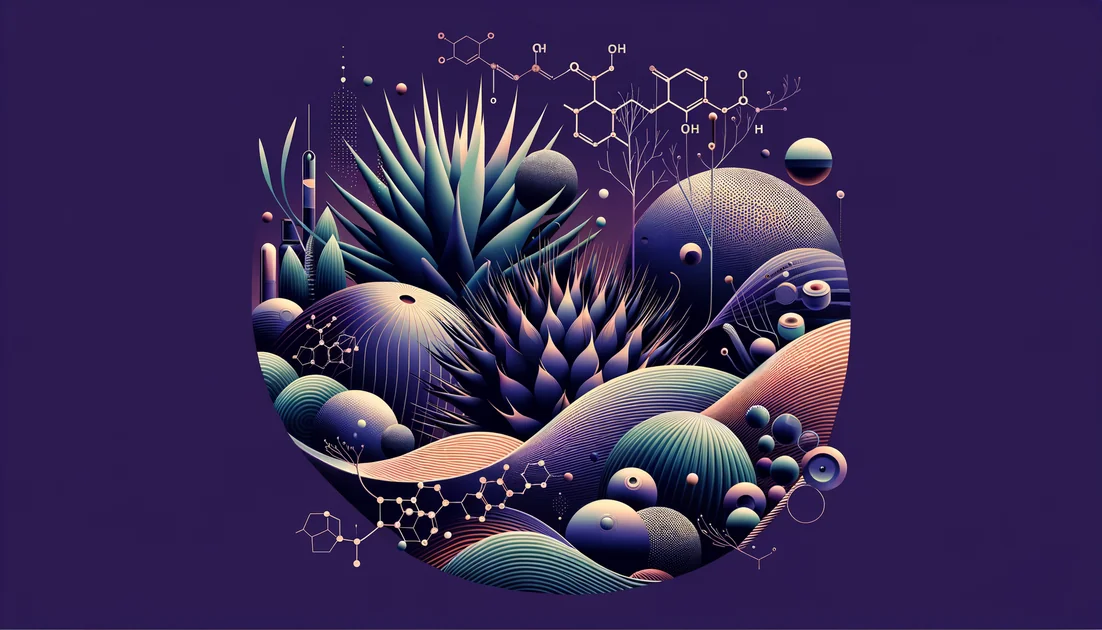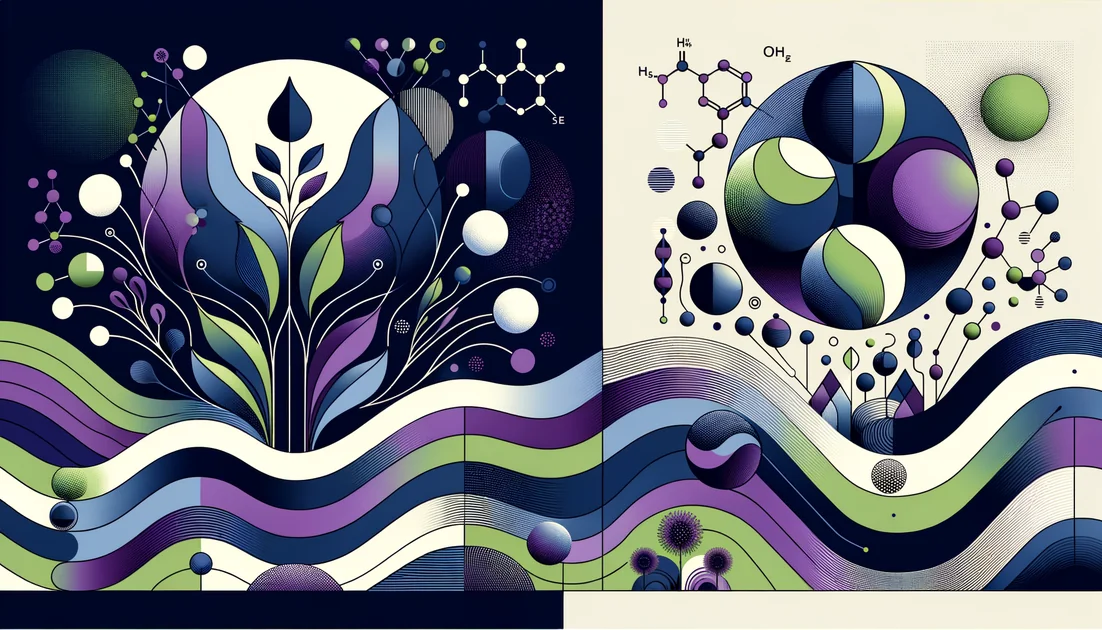
Claws in the Sand: How a Kalahari Root Moved From Desert Wisdom to the Pain Aisle
A century ago, a German trader in what is now Namibia learned from San and Nama healers about a bitter desert root they dug after the rains. By 1904, G.H. Mehnert was sending dried "devil's claw" tubers to Europe—an unlikely export born of hooked seedpods, harsh sand, and patient hands. Today, that same root sits on shelves for sore backs and aching knees. How did a thorny fruit become part of modern pain care—and what does the science actually say?[1][2]
- Evidence
- Promising
- Immediate Effect
- No → 4–8 weeks
- Wears Off
- Gradually over 1–3 weeks after stopping (uncertain)
From Hooked Fruit to Healing Roots
Devil's claw doesn't get its name from the part we drink or swallow. The fruits are spiked grapples that snag passing animals, hitchhiking seeds across the Kalahari. The medicine hides underground in the water-storing secondary tubers that desert families have used for fevers, stomach troubles, and pain for generations. Mehnert's early shipments lit a path from Kalahari camps to German laboratories, and by the 1950s European pharmacologists were probing the plant's bitterness for clues.[1][2]
Pain, Patience, and the Trials
When researchers finally put devil's claw into randomized trials for back pain, a pattern emerged: short-term pain relief—not dramatic, but measurable. A Cochrane review of herbal medicines for low back pain concluded that devil's claw standardized to 50–100 mg of harpagoside "may reduce pain more than placebo," and in one trial a 60 mg daily dose performed about the same as 12.5 mg of rofecoxib (Vioxx).[3][4] In a four-week, double-blind study of people with mild to moderate neck/shoulder/back pain, tablets delivering 2×480 mg of a standardized extract beat placebo on multiple pain and muscle-stiffness measures. Patients noticed the difference after several weeks, not overnight.[5] Open-label surveillance studies in osteoarthritis echo that "slow build": eight to twelve weeks of treatment saw 20–25% improvements across pain, stiffness, and function scores on the WOMAC index.[6][7] But the verdict isn't simple. A detailed review of osteoarthritis trials found methodological cracks and urged better, larger studies before anyone declares victory.[8] And in 2023 the World Health Organization's low-back-pain guideline issued a conditional "don't use routinely" recommendation, citing very low certainty—a reminder that small benefits and limited safety data don't always translate into standard care.[12]
What's Inside the Root—and Why It Matters
If you've ever looked at a label, you've seen the word "harpagoside." It's the root's best-known iridoid glycoside and the usual marker for standardization. But the chemistry acts more like a choir than a soloist. In a 2021 review, ethnopharmacognosist Thomas Brendler noted: "Whether harpagoside is more than just a marker.. remains to be demonstrated."[13] Likewise, European experts have long considered two sister species—H. procumbens and H. zeyheri—substantially comparable; botanists warn that judging products by harpagoside alone can mislead because total iridoids and overall extract profiles differ.[14][10] In lab models, full extracts down the body's chemical sirens—reducing signals that amplify pain and swelling (think: dialing back the volume on inflammatory messengers like TNF-α, IL-6, and COX-2 gene expression).[10] That might explain why standardized whole-root extracts tend to outperform isolated compounds in tests: the parts cooperate.[10]
Voices From the Kalahari
Behind every capsule is a harvest. In Namibia, women trained in sustainable digging slice away only the side tubers, then cover the crown so the plant regrows. "With two sacks.. I earned N$1,500.. I'll pay school fees and buy uniforms," said Tresia at a formal buying day—evidence that a desert plant can help fund classroom dreams when markets are fair.[15] Community projects report similar stories: "Devil's Claw.. provides [women] an opportunity" to earn cash where jobs are scarce, as conservancy leaders put it. Certification and seasonal permits aim to keep the wild populations—and livelihoods—intact.[2]
How It Feels in Real Time
Devil's claw isn't a fast-acting pill; it's a dimmer switch. Most trials showing benefit ran 3–8 weeks. People who respond typically notice easier mornings and longer walks after several weeks, with peak effects around a month or two.[5][6][7] Cochrane's back-pain trials used daily totals standardized to 50–100 mg harpagoside; that's the anchor most clinicians look for when comparing products.[3][4] If you decide to try it, think in seasons, not days:
Give it 4–8 weeks to judge benefit.
Look for labeling that states the harpagoside amount per day (50–100 mg) rather than just milligrams of "extract."[3][4]
Take with food if the bitterness unsettles your stomach. GI upset and headaches are the most common side effects reported; serious reactions are uncommon but possible.[9][16]
Safety, Quality, and Interactions—The Fine Print
Herbal medicine's promise lives or dies on quality control. A 2025 product survey highlighted wide variation in labels and cautions, underscoring the need for clearer dosing, interaction warnings, and species sourcing.[18] On the pharmacology side, devil's claw extracts can nudge the body's drug-transport systems (P-glycoprotein), at least in cells—raising a flag for potential herb–drug interactions.[11] Real-world case reports also suggest caution with blood thinners like warfarin; one report linked concurrent use to skin bleeding (purpura). While rare, guideline authors catalog these cases and advise monitoring if used together.[19] Regulators in Europe list mainly digestive side effects (nausea, diarrhea, abdominal pain), plus rare dizziness or allergic reactions. People with active ulcers or gallstones are generally advised to avoid it; so are those with certain heart rhythm issues until more is known.[9][16]
Where the Science Goes Next
The story of devil's claw is still being written. The evidence base is promising but uneven: multiple RCTs and open studies for back pain and osteoarthritis point to small-to-moderate relief over weeks, while authoritative guidelines press for larger, higher-quality trials before routine use.[3][4][5][6][7][8][12] Two threads feel most urgent:
Better trials and product standards so a dose on the label means a consistent experience for patients.[18]
Ethical, sustainable trade so the hands that lift the tubers from Kalahari sand share in the value, year after year.[15][2] Along the way, the plant keeps surprising the lab: whole extracts often outperform single molecules, hinting that the remedy San healers shared with Mehnert works not by one magic bullet, but by many small hands pulling together.[10]
"Whether harpagoside is more than a marker remains to be shown," notes Thomas Brendler, arguing for looking beyond one number on a label.[13]
"Both [devil's claw] species can be used interchangeably," says pharmacognosy expert Joerg Gruenwald, reflecting Europe's long practical view—provided quality is controlled.[14] Between the desert and the clinic lies a simple, human hope: to bend pain's arc without breaking the rest of life. For some, devil's claw moves that needle—slowly, modestly, and best with eyes open to the science, the source, and the people who harvest it.[3][5][12][15]
Key takeaways
- •Standardized extracts supplying 50–100 mg harpagoside per day show modest short-term relief in low back pain, with one trial matching 12.5 mg/day rofecoxib.
- •Expect gradual effects: treat devil's claw like a dimmer switch and reassess after 4–8 weeks rather than looking for overnight change.
- •Whole-plant extracts down-regulate inflammatory signals (TNF-α, IL-6, COX-2 mRNA) in cells; isolated compounds don't fully explain the effect, and harpagoside's role remains uncertain.
- •Best fit: adults with osteoarthritis or non-specific low back pain who want a gentler adjunct when NSAIDs are poorly tolerated or undesirable.
- •Practical use: take with meals for bitterness/GI comfort; check labels for harpagoside content—not just total "devil's claw."
- •Cautions: stop for rash, palpitations, dizziness, or persistent GI pain; avoid with active ulcers or gallstones; use care with arrhythmias, warfarin/anticoagulants, or complex regimens.
You might also like
Explore more of our evidence-led investigations, comparisons, and guides across every article style.

Kirkman (Kirkman®/Kirkman Laboratories)
Kirkman: Testing powerhouse with a checkered past—and a noticeable transparency upgrade

Theobromine vs TeaCrine (theacrine)
For smooth, long-lasting, low-stimulation energy, choose TeaCrine 100–200 mg in the morning; it shows sustained subjective energy without HR/BP spikes. Pick theobromine only if you want the mildest CNS effect and lowest "buzz," but expect little measurable energizing benefit. [1][2][7]


L-Phenylalanine
A mother waits outside a lab in 1934, pleading for answers about the strange, musty smell in her children's urine. Decades later, a dermatologist times a UV lamp to the minute after a patient swallows an amino acid. Today, a researcher hands volunteers a phenylalanine drink and watches their hunger ebb. The common thread is a single molecule—L-phenylalanine—an essential building block that can color skin, quiet appetite, and, in rare cases, cause harm if your biology can't process it.

Sleep & Recovery: The Athletic Triangle
Magnesium + B6 shows small, condition-specific synergy; adding zinc hasn't proven extra benefits and can compete with magnesium at high doses.

Tocotrienols
The stealthier cousins of vitamin E—built with springy tails that move differently in cell membranes and behave differently in your body.


